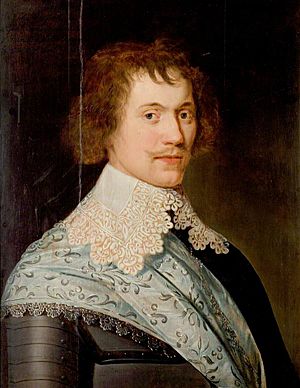Thomas Byron facts for kids
Quick facts for kids
Sir Thomas Byron
|
|
|---|---|

1631 portrait by Joachim Houckgeest
|
|
| Born | c. 1610 Colwick, Nottinghamshire, England |
| Died | 5 February 1644 (aged 33–34) Oxford, England |
| Allegiance | Royalist Army |
| Battles/wars | Battle of Edgehill Battle of Hopton Heath |
Sir Thomas Byron (born around 1610 – died February 5, 1644) was an important officer for the King's side, known as the Royalists, during the First English Civil War. He was in charge of the Prince of Wales' cavalry (horse soldiers) for the first year of the war. He fought bravely in major battles like the Battle of Edgehill in 1642. A few months later, at the Battle of Hopton Heath, he led a charge that helped the Royalists win and capture enemy cannons. Sadly, he was attacked by one of his own soldiers in late 1643 and died from his injuries in early 1644.
Early Life and Family
Thomas Byron was born around 1610. His parents were Sir John Byron of Newstead Abbey, Nottinghamshire, and Anne Molyneux. He was one of seven sons. The Byron family owned a lot of land in Nottinghamshire and Lancashire, making them very important in those areas.
Thomas's great-grandfather and grandfather both served as High Sheriff of Nottinghamshire. This was a very important local government job. His grandfather was also a Member of Parliament for the county in 1597. However, the family's wealth decreased during his grandfather's time, as he had to sell some land to pay off debts. Thomas married Katherine Braine. They had two children, Thomas and John, but both died when they were babies. Katherine lived longer than Thomas and was buried at Westminster Abbey in 1676.
Fighting in the English Civil War
When the First English Civil War began in 1642, Thomas and all his brothers strongly supported King Charles. All seven Byron brothers fought for the Royalist side. His oldest brother, Sir John Byron, was known for creating the first Royalist cavalry regiment. Three of his younger brothers became officers in this group.
Thomas Byron was made a colonel of the Prince of Wales' cavalry regiment. He also commanded the Prince's own troop, which was one of seven groups in the regiment. King Charles made him a knight on September 27, in Shrewsbury.
Key Battles and Actions
At the Battle of Edgehill in October 1642, Thomas's regiment fought on the Royalist's right side. During the battle, Byron saved one of his men, Richard Bulstrode, by shooting a Parliamentarian soldier who was attacking him. In November, he received a special degree from Oxford University.
That same month, during the Royalist campaign in the Thames Valley, Byron and his older brother John took over Fawley Court. This was the home of Bulstrode Whitelocke, a Parliamentarian. The Royalist soldiers were searching the house. Byron found Whitelocke's children hiding nearby. He protected them from harm, saying it would be "barbarous" (very cruel) to hurt "innocent children." The next January, his regiment stayed in Oxfordshire and received money to support themselves.
By 1643, Edward Hyde, 1st Earl of Clarendon, a famous historian, said that Byron was the real commander of the Prince of Wales' regiment. Even though Henry Clifford, 5th Earl of Cumberland officially held the position, Byron was in charge. Clarendon called Byron a "very valuable and experienced officer."
In March 1643, at the Battle of Hopton Heath, the Royalist commander, the Earl of Northampton, was killed while leading a cavalry attack. Byron then led a second charge. This attack successfully took over the enemy's cannons and pushed their cavalry off the battlefield. Byron himself was hurt, getting a wound in his leg. After he recovered, Byron was ordered to help Lord Hopton. Lord Hopton was planning to attack Surrey and Sussex after his campaign in the southwest. Byron and his regiment joined forces with Hopton in November 1643.
Death
On December 7, 1643, Byron was attacked in Oxford. He was leaving his home when one of his own soldiers, Captain Hurst, attacked him. This happened because of a disagreement about pay. The historian Peter Young thinks Byron might have been on leave from his regiment at the time. Captain Hurst was executed the next week. Byron died from the chest wound he received in the attack two months later, on February 5, 1644. He was buried four days later at Christ Church Cathedral, Oxford.

